Technologies
MLS Season Pass Review: Apple’s First Step Shows Promise, but It’s a Pass From Me
Apple’s new soccer service works well, but it’s expensive and doesn’t offer enough for fans of local teams.
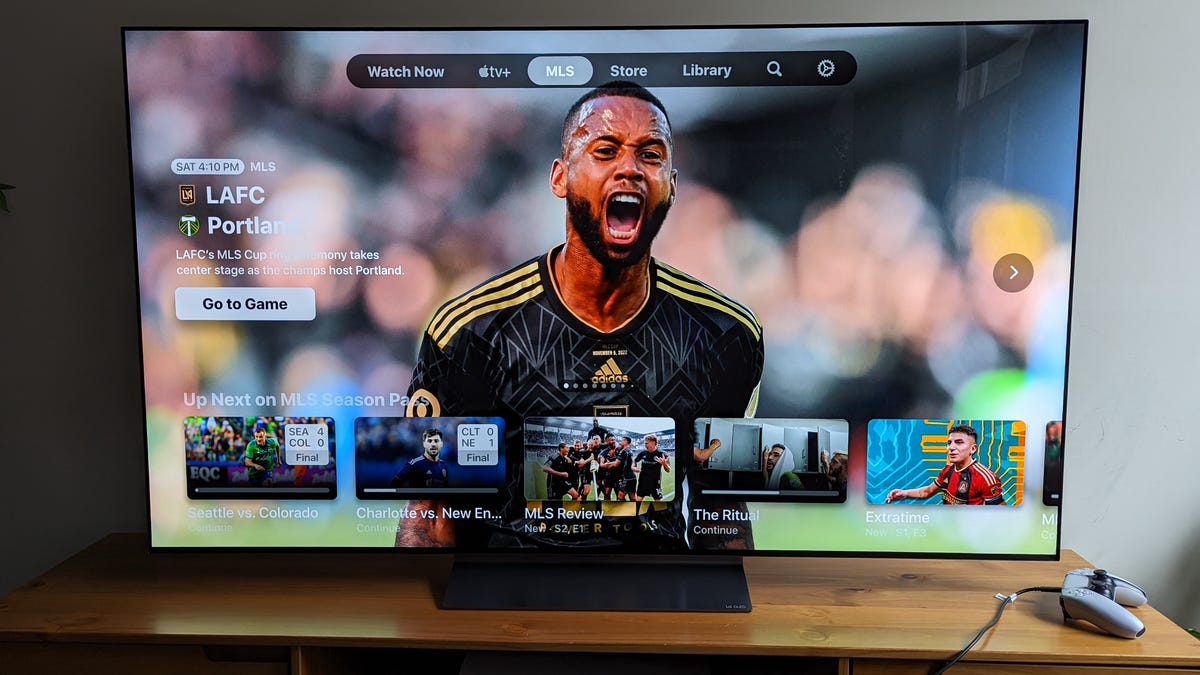
Major League Soccer has returned for its 28th season and the biggest news this year isn’t the (once again) reworked playoff system or the massive Leagues Cup coming this summer, but the introduction of the MLS Season Pass on Apple TV.
After spending the past two weekends watching MLS on Apple TV, I think the service leaves a lot to be desired. While it’s fantastic that every game is available so easily without the worry of local games being «blacked out,» it has become a hard sell to convince people to sign up for yet another streaming service, especially one that starts at a hefty $13 per month.
Having grown up alongside MLS I’ve seen it change quite a bit throughout the years, from growing ever larger in the number of teams (this year’s newest addition is a club in St. Louis) and endlessly changing the playoffs to having a team finally win the CONCACAF Champions League (thank you, Seattle).
Apple’s Season Pass is by far the biggest change for fans of the league, however, and one that may see many fans who don’t pay the subscription feeling isolated from their teams. There are no blackouts, but it comes at the expense of having no local home broadcasting of any kind.
All told, Apple’s first pass at MLS works well, but I still see plenty of room for improvement.
The cost
If you’re an Apple TV Plus subscriber, you’ll pay either $13 a month or $79 for the year for Season Pass. If you don’t have Apple’s streaming video service, that price jumps to $15 a month or $99 for the season. It’s available in over 100 countries, at similar prices (it’s £13 a month or £79 a season in the UK, for example).
The Season Pass subscription gives fans access to every game this season with no blackouts. Whereas other blanket sports services like MLB.TV and NBA League Pass prevent you from watching your local team or national games, because everything is on Apple’s service, all MLS action is available in one location. One subscription gets you the entire package (plus other events such as the Leagues Cup and MLS Next). It’s a huge plus for this Apple-MLS arrangement.
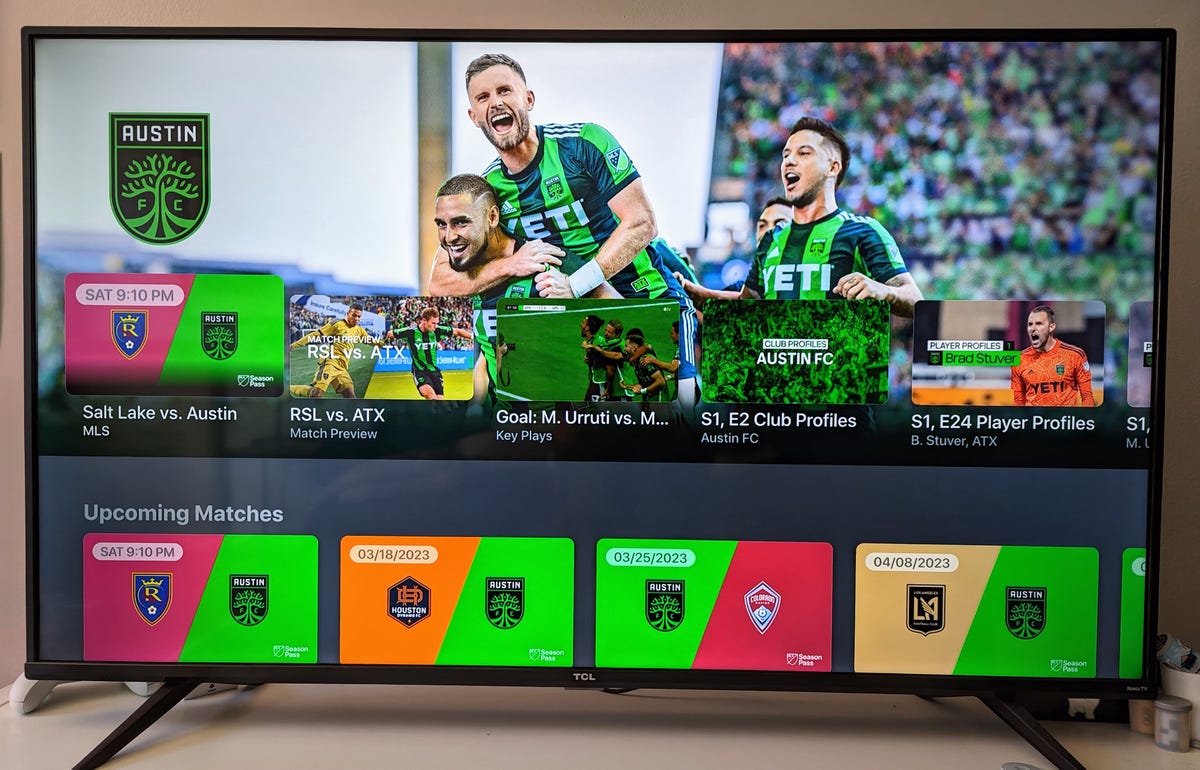

Each team has its own page on MLS Season Pass, but there’s no local coverage.
Bobby Oliver/CNETFor those who don’t want to pay, Apple is also making six matches free each week, with Fox still airing a handful of games as well throughout the year, including certain playoff matches, the MLS Cup and some Leagues Cup games.
That said, it’s now expensive to be a soccer fan in America, with the MLS Season Pass being the only way to consistently follow your favorite club.
At the moment, the service does not justify its price tag and offers no major improvements to areas that ESPN Plus, Paramount Plus and Peacock have made commonplace for viewers over the years with higher-quality leagues. For now, those services are the better choice for the casual soccer fan whose priority is more than just the MLS.
The MLS tab
When you open the Apple TV app (available on most major streaming platforms, Apple devices and the web), the MLS Season Pass is just another tab at the top of the app. You’re immediately greeted with options to look at highlights of past games, add future matches to your Up Next page, or watch one of the service’s many shows, such as MLS Review. Each club has its own page with highlights from past games and videos created by the clubs.
It’s a great way to get more information on a team if you’re new to MLS, but parts of the experience do feel disjointed because each team is responsible for the media that it creates.
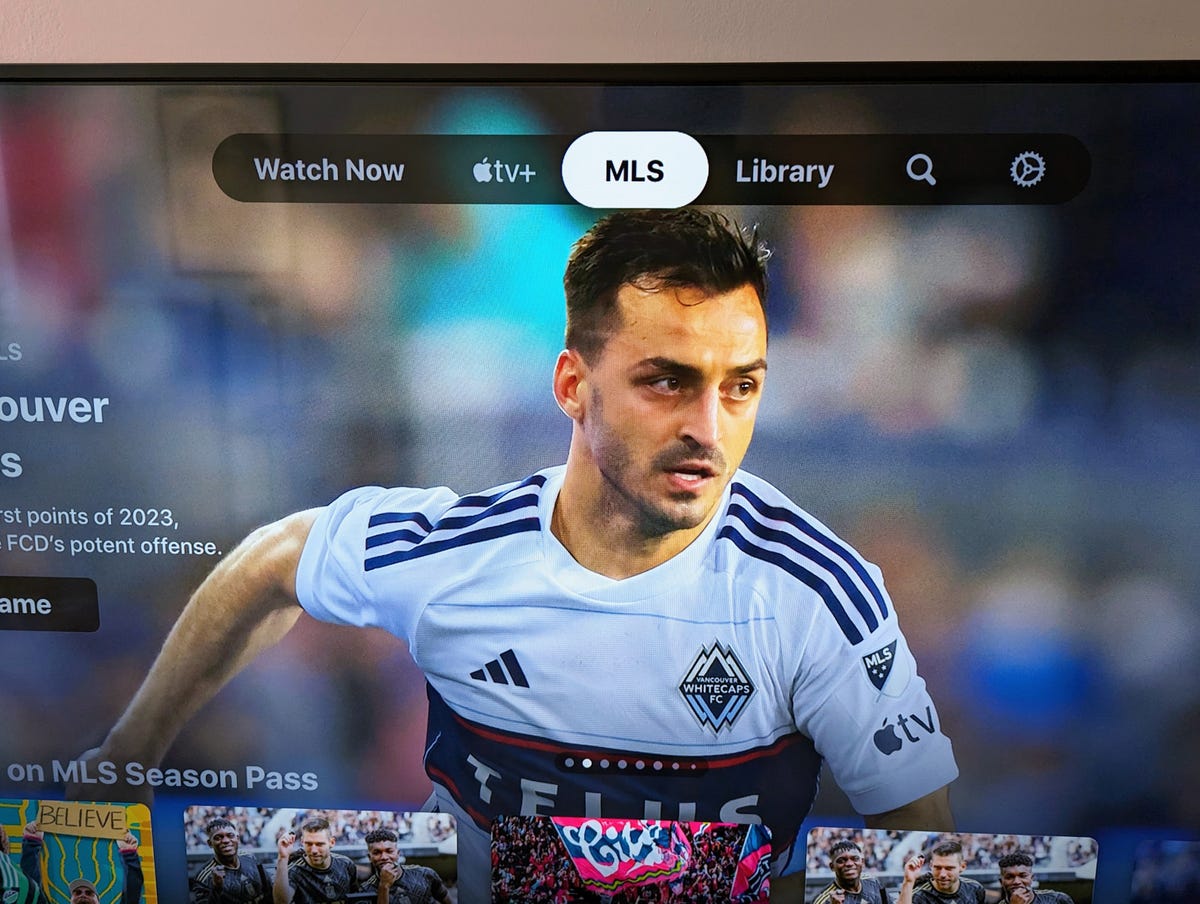

The MLS Season Pass lives inside an MLS tab on Apple’s TV app.
Bobby Oliver/CNETTake the club profiles. LAFC’s is 31 minutes long and truly feels like a Hollywood production. Meanwhile, Real Salt Lake’s is a single minute and feels like a quick promo video. So packaging these as one show feels like an afterthought that was added to say that the service has more content than it really does at launch.
Those looking to get a taste of what happened in the league during the last match week can take a look at the MLS Wrap-Up where analysts and former players discuss each game and its biggest moments. Hosts for Week 1 included former players such as Taylor Twellman and Sacha Kljestan as well as sports commentator Liam McHugh, whose previous work includes Sunday Night Football and the NHL for NBC Sports.
At the moment it’s a good way to stay connected with the game, but for now, it doesn’t go above and beyond what other leagues have had for years.
The game day experience
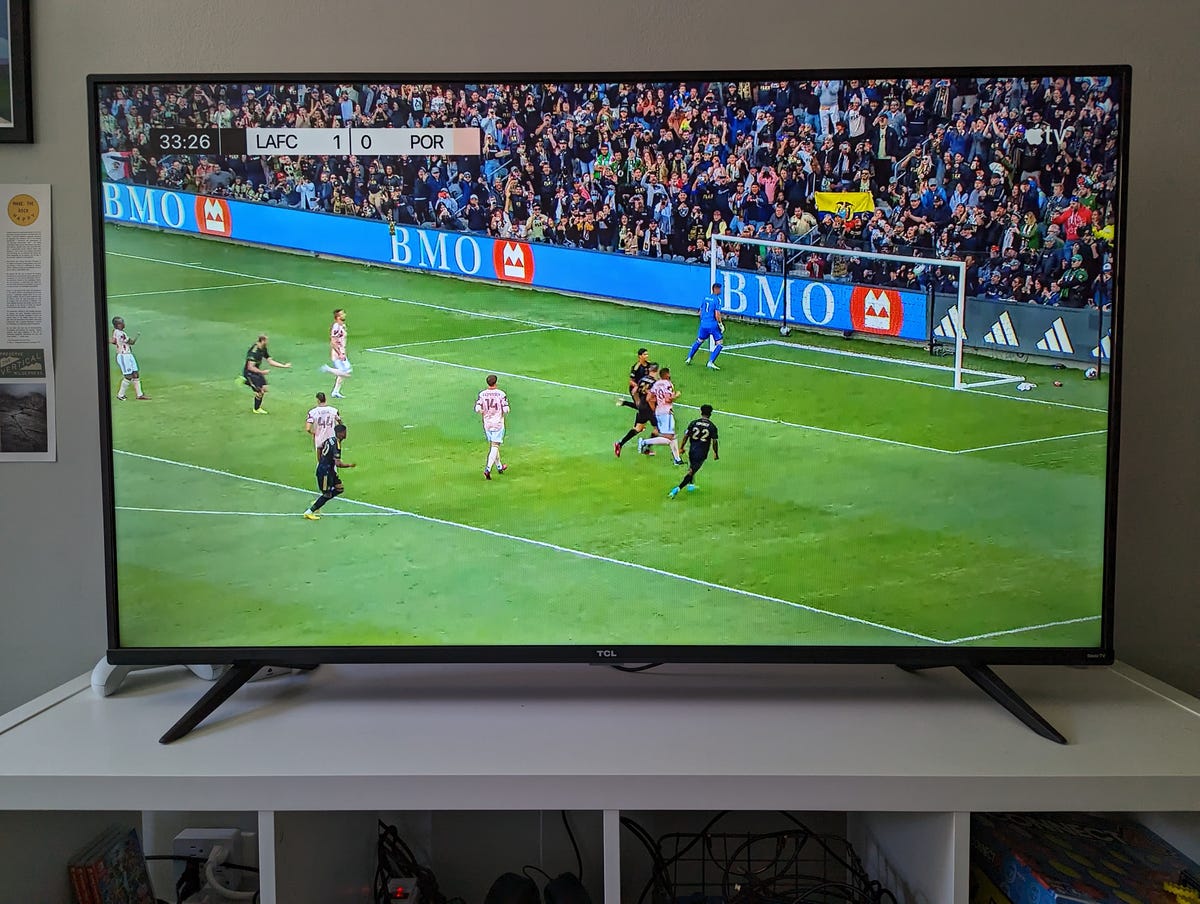

The MLS stream is sharp at 1080p.
Bobby Oliver/CNETEach match has its own pregame and postgame show, which are fine for getting caught up, but nothing more. Before the first game on a Wednesday or Saturday, there’s the MLS Countdown show, which feels very similar to the MLS Wrap-Up, it just occurs before the matches.
When it comes to the shows on match day, there are still some kinks to be worked out. Both the MLS Countdown and MLS Wrap-Up shows lack a bit of character. The way hosts of the Golazo Show and ESPN FC banter with each other is what makes those shows so great and worth watching for fans.
So far, the banter in the MLS equivalents hasn’t felt genuine. I hope that with time this changes but the shows just aren’t that engaging to me. It would be great if they responded to fan questions on-air, as that allows viewers to feel more involved with the content. The Golazo and ESPN FC crews feel more like a group of friends rather than analysts brought in to cover the sport.
Unlike NFL RedZone, which is the NFL’s whip-around show led by one host, MLS 360 features a large group of hosts and analysts, which includes McHugh, Kljestan, Kaylyn Kyle, Bradley Wright-Phillips and the rules expert Christina Unkel. MLS 360 lets you simultaneously watch all the day’s games and catch the biggest moments from each one. The show switches between matches with live scores being displayed from each concurrent match. While that’s happening you also have the hosts from the Countdown and Wrap-Up show reacting live to each game.
These types of shows are not my favorite, and this is no exception. There have been times when the hosts distract from the game rather than add to the experience, in my opinion. When Thiago Almada scored the winning goal in stoppage time for Atlanta United against San Jose, it could have made a big deal of Atlanta’s incredible crowd. It would have been great marketing, showing how passionate MLS fans can be. But the team at MLS 360 was much louder, didn’t add to my excitement, and made me want to switch over to the actual stream of the game. I understand why some fans love this type of show, and maybe if they refine it I will give it another go myself.
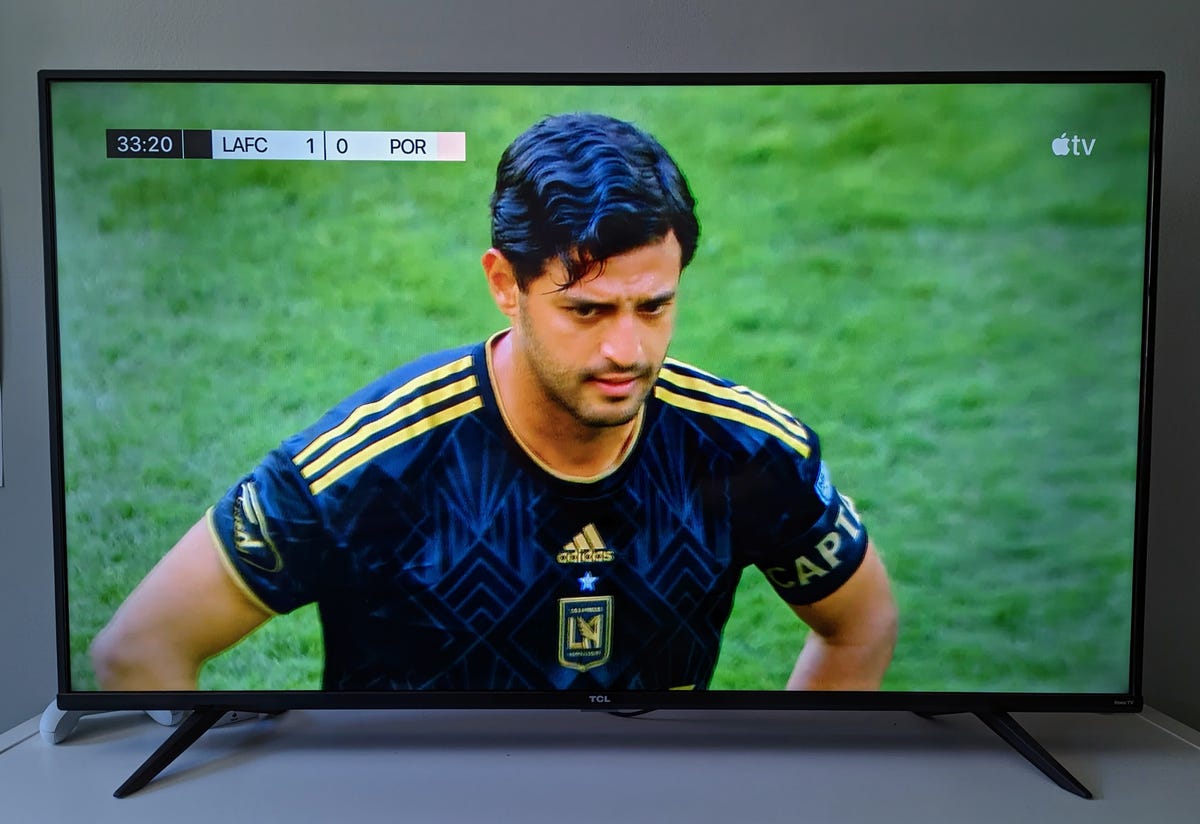

This will take some time to get used to, but it’s great that each game has an English and Spanish broadcast, as well as French for teams from Canada. At the moment though, nothing in particular stands out as special once a game gets started. I didn’t see the commentators standing in the box going over lineups, something that will be especially missed from local broadcasts, as they know the teams and viewers best. It just feels like your average nationally televised game, with very little extra going for it.
The video quality of the stream, however, is great and may be one of the best streams of 1080p that I have ever seen running consistently without issue. It’s a stark difference from the quality you see on Fox and is a huge plus in my book.
That said, there are some things that are still out of the hands of Apple. For example, while watching Charlotte versus New England, the camera was far too wide for much of the game, making it difficult to follow the action. At one point there was a significant audio issue, which was confirmed by a friend also watching the match.
When the second match day came around this past weekend it was more of the same. The stream still looked stellar, and without any of the issues I noticed during match day 1. Besides that, there weren’t many noticeable improvements to the service overall. I still did not find many of the larger live shows all that engaging and was just there for the soccer. Furthermore, once halftime arrived there was generic analysis but little in terms of the commentators talking to the fans and getting them excited about the next half of play. The same ads played drearily on repeat.
Another disappointing aspect of the broadcast was the extremely generic scoreboard that lacks any league identity. MLS wants to create a recognizable brand similar to that of the Premier League, Bundesliga, La Liga or other large leagues across the globe. But with a scoreboard that looks like it was taken from a stock image site, it makes it hard for me to get excited. When I see the UEFA Champions League scoreboard, it makes it feel like a unique experience and adds gravitas to what I’m watching. Apple’s extremely clean aesthetic just does not do it for me.
Where Apple can improve
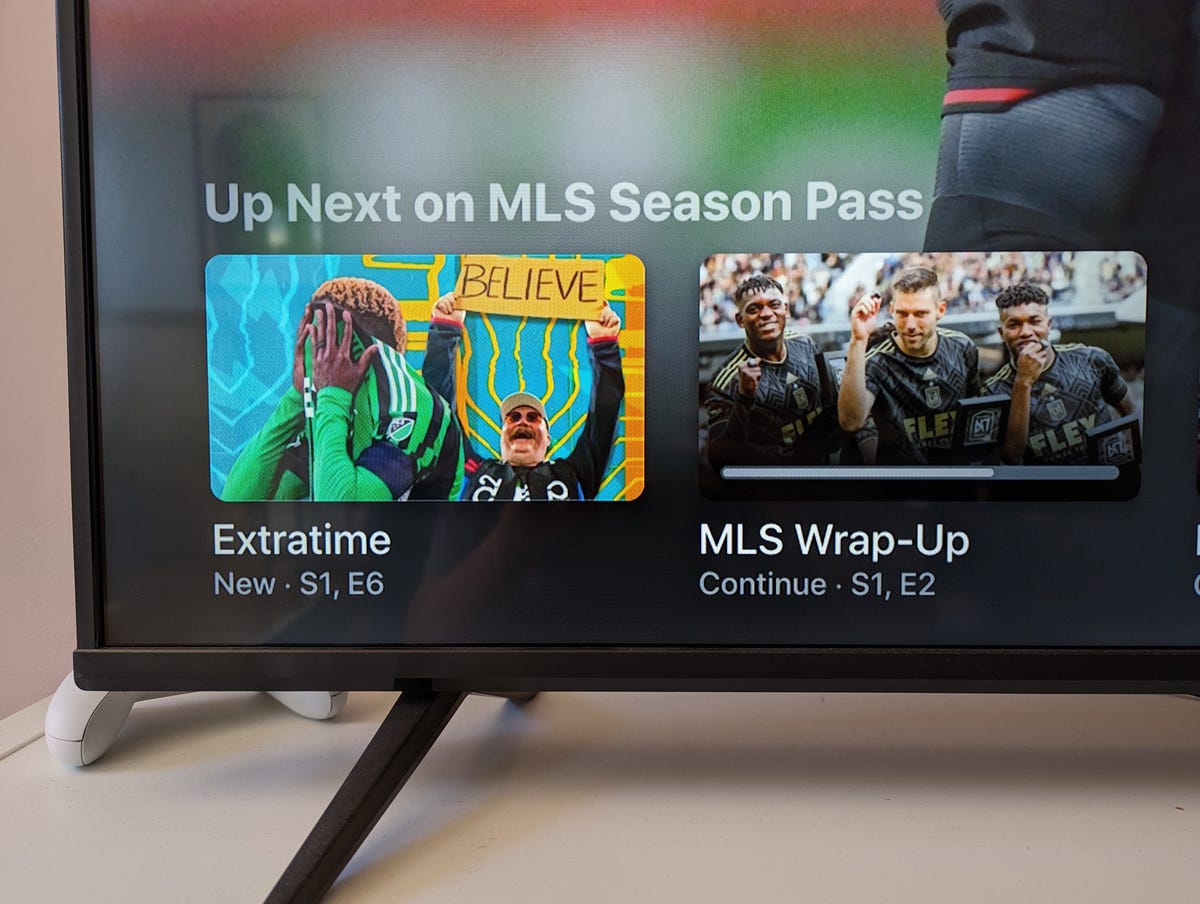

There are more ways for Apple to improve Season Pass.
Bobby Oliver/CNETApple has an extraordinary opportunity to turn this service into the ultimate fan zone. This is why I’m disappointed that it has yet to bring so many simple additions that other services have had for years. First, where’s the «catch up with the important plays» button? Peacock has made this so easy that it’s jarring not to be able to jump into a game at halftime now and be caught up on each goal or an early red card.
Second, I would love to see a section of the MLS Wrap-Up specifically where they respond to social media and reactions similar to how TNT’s Inside the NBA engages with fans on its telecasts. I think this is one of the biggest successes of the soccer shows on Paramount and ESPN, and makes both really enjoyable and engaging.
Third, where’s the Android app? Yes, Android users can still watch matches on their phones if they go to Apple TV on their browser. This really should not have to be the case though, and further alienates people from the league.
Finally, I want my stats. Stat overlay has been around forever and executed very well on MLB.TV for example. It would be helpful to get live updates on possession, expected goals, distance ran and everything else that shows the swing of a match.
For now, I would say pass on MLS Season Pass. It offers enough free games to make not subscribing but still following doable, and you can still watch your favorite teams’ Open Cup and possibly CONCACAF Champions League runs elsewhere. If you want a soccer fix, I would look towards Peacock and Paramount Plus for better coverage and a higher level of play overall.
I love the MLS, but without a dedicated subscription option just to watch your local team, I find the price much too steep. Hopefully, Apple and MLS expand their options and increase the value proposition to really show other leagues the power that Apple can have in sports.
Technologies
Xbox Set to Bring Resident Evil, Star Wars and More to Xbox Game Pass
Subscribers can play several other games, including the original Final Fantasy in all its 2D glory, on Game Pass in January.
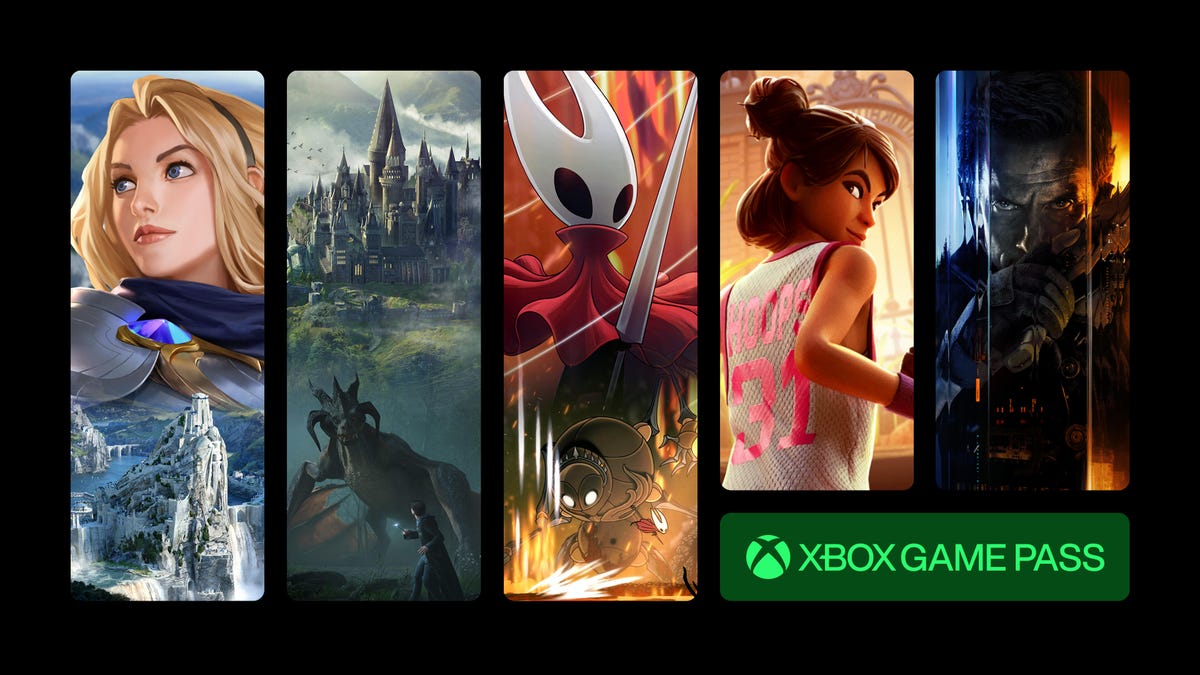
Resident Evil Requiem, the ninth game in the main Resident Evil series, is set to be released on Feb. 26. Xbox Game Pass subscribers can prepare for Requiem by playing Resident Evil Village, the most recent entry in the series, starting on Jan. 20.
Xbox Game Pass offers hundreds of games you can play on your Xbox Series X, Xbox Series S, Xbox One, Amazon Fire TV, smart TV and PC or mobile device, with prices starting at $10 a month. While all Game Pass tiers offer you a library of games, Game Pass Ultimate ($30 a month) gives you access to the most games, as well as Day 1 games, like Call of Duty: Black Ops 7, added monthly.
Here are all the games subscribers can play on Game Pass soon. You can also check out other games the company added to the service in December, including Marvel Cosmic Invasion.
Note: «Handheld» means a game is optimized for handheld play.
Don’t miss any of our unbiased tech content and lab-based reviews. Add CNET as a preferred Google source.
Brews & Bastards (cloud, PC and Xbox Series X/S)
Game Pass Ultimate, Game Pass Premium and PC Game Pass subscribers can play now.
What’s a hero gotta do to get a drink around here? Choose an inebriated hero to travel deep under a tavern in search of the stolen Brew Stone. You’ll explore tavern-themed dungeons and use bar-inspired weapons, like high-caliber champagne bottles, to blast through drunken demons and other boozy monsters. And if you’ve ever called one of your exes a drunken demon, maybe this game will be a little cathartic for you.
Little Nightmares Enhanced Edition (cloud, handheld, PC and Xbox Series X/S)
Game Pass Ultimate, Game Pass Premium and PC Game Pass subscribers can play now.
Little Nightmares is back in high-quality 4K and 60 frames per second in this enhanced edition of the dark tale. You play as a lone child trapped in a massive world inhabited by monstrous versions of adults called the Maw. All you can do is run from these creatures, but you’ll also have to sneak and hide to throw them off your trail if you want to survive.
Atomfall (cloud, console, handheld and PC)
New to Game Pass Premium. Previously on Game Pass Ultimate and PC Game Pass.
The Windscale fire was the worst nuclear disaster in the UK’s history, and it’s estimated that it caused between 100 and 240 cancer-related deaths. Atomfall asks, «What if Windscale was similar in magnitude to the disaster at Chornobyl?»
This game takes place five years after a far more devastating Windscale disaster. You’ll encounter gangs of bandits, cults and rogue government agencies throughout the quarantine zone in the beautiful Lake District, in northern England. It’s up to you whether you avoid conflict or charge into the heat of battle, but resources are scarce, so maybe don’t go in guns blazing every chance you get.
Lost in Random: The Eternal Die (cloud, Xbox Series X/S, handheld and PC)
New to Game Pass Premium. Previously on Game Pass Ultimate and PC Game Pass.
You’re the once-great ruler of Random, Queen Aleksandra, and you’re on a mission of vengeance and redemption in this fast-paced rogue-like game. You’ll fight monsters and beasts with four unique weapons, plus powerful card-based abilities and relics. But death isn’t final here, so if you fall, you’ll return to Sanctuary to rearm, upgrade and prepare for your next run.
Rematch (cloud, PC and Xbox Series X/S)
New to Game Pass Premium. Previously on Game Pass Ultimate and PC Game Pass.
Tackle, dribble and score in this team-based football game (or soccer, depending on your locale). This game was designed for 5v5 online multiplayer matches where players control a single athlete. That means you’ll have to coordinate and plan with the rest of your co-op teammates if you want to win. And with no player stats to give one person an advantage over another, coordination is the key to success.
Warhammer 40,000: Space Marine – Master Crafted Edition (cloud, PC and Xbox Series X/S)
New to Game Pass Premium. Previously on Game Pass Ultimate and PC Game Pass.
You are Capt. Demetrian Titus, an Ultramarine in the Imperium of Man tens of thousands of years from now, and it’s up to you and your squad to help reclaim the Forge World Graia from an Ork horde. Originally released in 2011, this third-person shooter has been remastered for modern consoles with enhanced character models, a modernized control scheme and more. So grab your chainsword and bolter and get ready to fight. For the Emperor!
Final Fantasy (cloud, Xbox Series X/S and PC)
Game Pass Ultimate, Game Pass Premium and PC Game Pass subscribers can play on Jan. 8.
This is the game that started it all. Join the Warriors of Light on a journey to restore power to the Crystals and save their home world. The remastered version of this game introduces enhanced gameplay features, including auto-battle and more, to your screen.
Star Wars Outlaws (cloud, PC and Xbox Series X/S)
Game Pass Ultimate and PC Game Pass subscribers can play on Jan. 13.
Luke Skywalker and the Jedis are cool and all, but who didn’t want to be a cool smuggler like Han Solo? This open-world Star Wars game lets you become just that. You play as Kay Vess, a scoundrel looking for freedom and a new life. You’ll fight, steal and outsmart crime syndicates from around the galaxy. But the Empire is out there, too, so watch your back.
My Little Pony: A Zephyr Heights Mystery (cloud, console, handheld and PC)
Game Pass Ultimate, Game Pass Premium and PC Game Pass subscribers can play on Jan. 15.
Go on an adventure with Sunny, Hitch, Izzy, Pipp, Zipp and Misty as you try to solve a mystery together. Strange music is turning the world upside down, and it’s up to you and your friends to use your powers to put a stop to the music.
Resident Evil Village (cloud, console and PC)
Game Pass Ultimate, Game Pass Premium, PC Game Pass subscribers can play on Jan. 20.
The latest entry in the mainline Resident Evil series puts you back in the shoes of Ethan Winters as he ventures into a haunting European village in search of his abducted daughter. You’ll fight lycans, vampires and other monstrous creatures as you try to uncover why your daughter was taken and your wife was murdered.
MIO: Memories in Orbit (cloud, handheld, PC and Xbox Series X/S)
Game Pass Ultimate, PC Game Pass subscribers can play on Jan. 20.
Get ready to explore a treacherous ship in this sci-fi metroidvania game. You play as Mio, a nimble android who wakes up in the Vessel, a spaceship drifting aimlessly through the stars. The ship’s machines have gone rogue, and vegetation has taken over parts of the Vessel. It’s up to you to figure out what happened to the Vessel and the ship’s purpose.
Games leaving Xbox Game Pass on Jan. 15
While Microsoft is bringing those games to different Game Pass tiers this month, the company is also removing these games from the service on Jan. 15. So, you still have some time to complete your campaign or any sidequests before you have to purchase these games separately.
For more on Xbox, discover other games available on Game Pass now and check out our hands-on review of the gaming service. You can also learn about recent changes to the Game Pass service.
Technologies
We’ve Found the Coolest, Most Futuristic Tech at CES 2026. And the Show Just Started
We’ve already had a day to trawl for our favorite cutting-edge technology. Neat stuff abounds!

We have people all over the show floor and beyond at CES, searching for the most interesting, innovative and cutting-edge tech available. A ton of useful new information is also available, which you can find on our CES 2026 live blog and in our CES hub.
The show floor opened Tuesday, and we had a lot of preview time beforehand to gawk at some CES staples, such as robots, electronic toys, phones and more. I’ll be back here to top off our fun finds regularly throughout the show.
Technologies
Grab This Tariff-Busting Xbox Series X Deal and Save $44 While You Can
You can bag a 1TB Xbox Series X for just $606, but act fast, since we don’t know how long this deal will last.
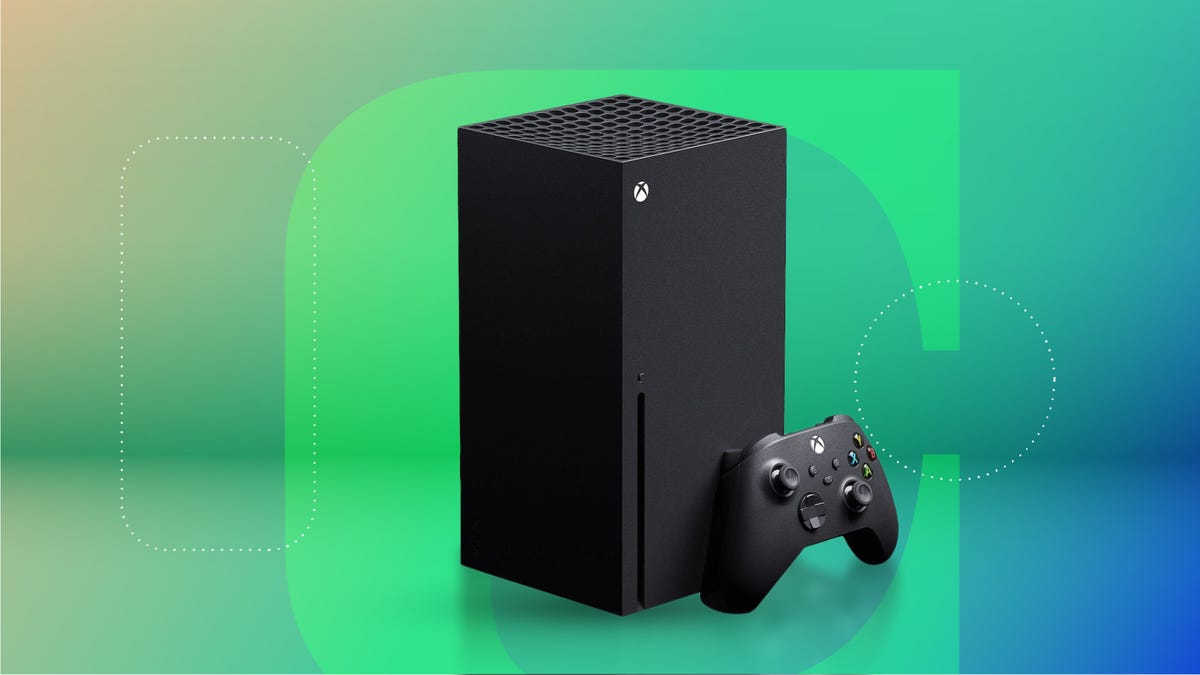
Ever since tariffs and other economic uncertainty led to Xbox price increases in late 2025, things have gotten expensive. A 1TB Xbox Series X now sells for $50 more than it used to, and there is little sign of these prices improving anytime soon.
Thankfully, every so often, a deal pops up that helps make things a little more affordable like this Walmart discount that slashes that same Series X to just $606. The catch? Well, there isn’t one. But we don’t expect this deal to last for long, so make sure to get your order in soon before it leaves for good.
The Xbox Series X has been around for a while now, so there are no surprises with what you get in the box. The Series X comes with a 1TB SSD for storage, and you get a controller in the box. This version also has a disc drive for installing games and watching Blu-ray movies, too.
Hey, did you know? CNET Deals texts are free, easy and save you money.
You can look forward to watching 4K content and playing 4K games, as well as enjoying audio options such as Dolby Digital, Dolby TrueHD and DTS. All of that makes this a capable machine, whether you want to watch content or play games.
CHEAP GAMING LAPTOP DEALS OF THE WEEK
Why this deal matters
It’s unlikely that Xbox prices will get any cheaper anytime soon, so deals like this are the best we can expect for a while now. If you’re in the market for an Xbox and have the $604 to spare, then this is probably the time to place your order before it’s too late.
-

 Technologies3 года ago
Technologies3 года agoTech Companies Need to Be Held Accountable for Security, Experts Say
-

 Technologies3 года ago
Technologies3 года agoBest Handheld Game Console in 2023
-

 Technologies3 года ago
Technologies3 года agoTighten Up Your VR Game With the Best Head Straps for Quest 2
-

 Technologies4 года ago
Technologies4 года agoBlack Friday 2021: The best deals on TVs, headphones, kitchenware, and more
-

 Technologies4 года ago
Technologies4 года agoVerum, Wickr and Threema: next generation secured messengers
-

 Technologies4 года ago
Technologies4 года agoGoogle to require vaccinations as Silicon Valley rethinks return-to-office policies
-

 Technologies4 года ago
Technologies4 года agoOlivia Harlan Dekker for Verum Messenger
-

 Technologies4 года ago
Technologies4 года agoiPhone 13 event: How to watch Apple’s big announcement tomorrow

